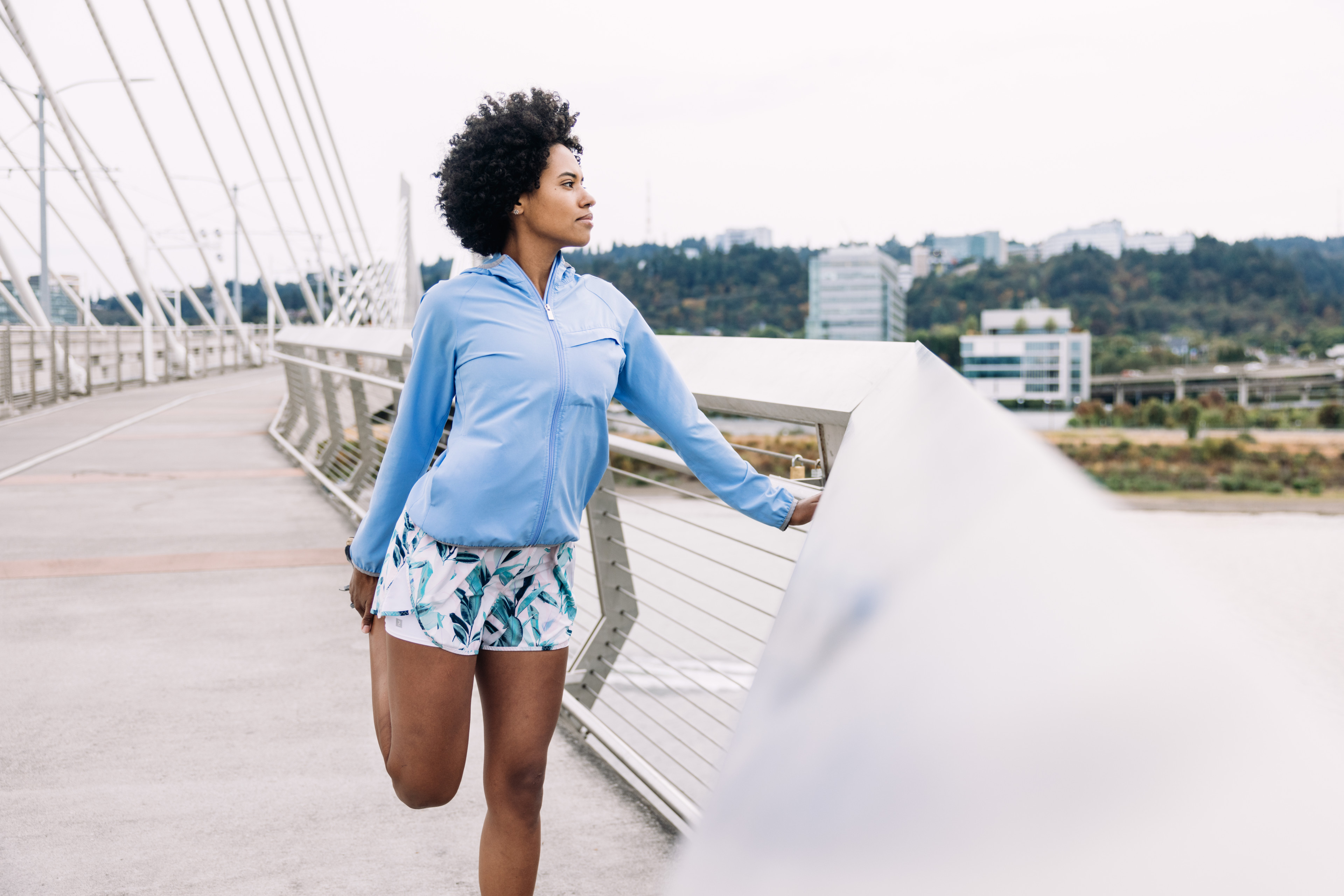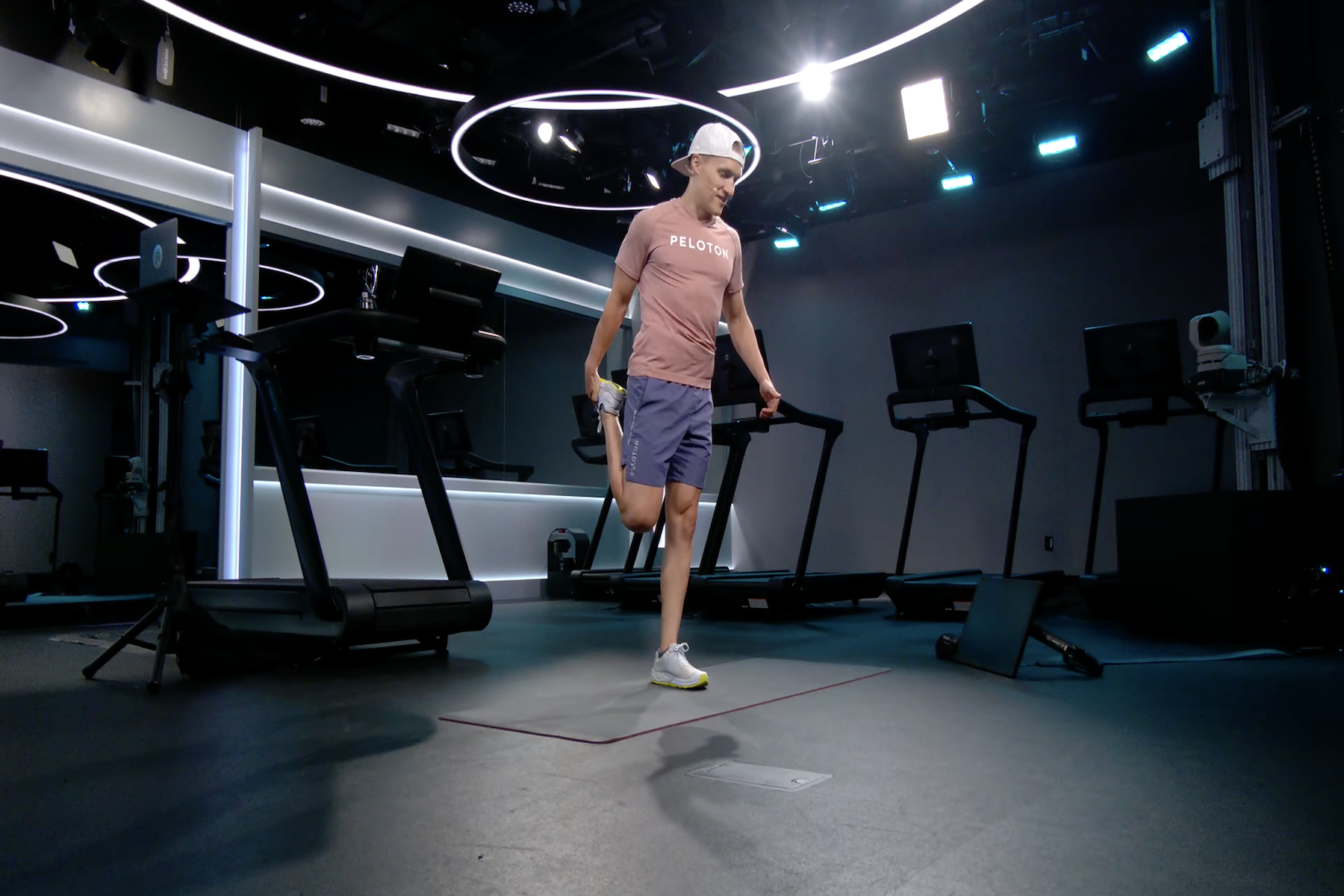
RyanJLane/E+ via Getty Images
The 5 Best Quad Stretches for Runners and Cyclists
Don't neglect these stretches for a balanced body and better performance.
By Jennifer Heimlich•
Why Quad Stretches Are Crucial For Runners and Cyclists
The Benefits of Stretching Your Quads
The 5 Best Quad Stretches to Try
How To Add Quad Stretches to Your Fitness Routine
Runners love to run. Cyclists love to cycle. And both types of athletes have bad reputations for skipping out on some of the supplemental work that keeps our bodies balanced and injury-free. But one thing you absolutely don’t want to overlook are quad stretches.
“The quads work closely with the tendons and joints of the knee and the hip, so stretching the quads can really help to reduce the chance of an injury,” Peloton instructor Hannah Frankson. “It can also improve the effectiveness and efficiency of the muscle allowing full range of movement in the quad.”
Obligatory quad stretching might feel like the equivalent to flossing your teeth, but there’s a reason why our dentists and trainers keep harping on us to do these things: You won’t like the long-term consequences if you neglect these simple steps.
Why Quad Stretches Are Crucial For Runners and Cyclists
The quads are the most powerful muscle group in the legs, consisting of four muscles at the front of the thigh that attach to our hips and knees. They have two jobs: to flex the thigh at the hip joint and to straighten the leg at the knee. Which means, when it comes to cycling and running, the quads are largely in charge. “The quads are one of the main muscle groups used when pushing down on the pedals and down into the ground to create forward force when running,” Hannah says.
Considering that we repeat those motions over and over again when running and cycling, that means these muscles get quite a bit of wear and tear. If you’re not doing proper warm-ups and cooldowns or strength training and stretching, you can end up with extremely tight quads that could potentially lead to injury.
The Benefits of Stretching Your Quads
Since the quads connect to both the knee and hip joints, keeping them loose and mobile can reduce your risk of overuse injuries such as IT band tightness, or tendonitis in the hips or knees.
More mobile quads will also give you a more efficient stride or pedal stroke. That’s because letting the quads get too tight could shorten your range of movement, says Hannah. “[With] more mobile quadriceps, you can strengthen them through the full range of motion and be able to gain more power that way,” says Greg Nordlund, an athletic trainer with Northwestern Medicine.
TL;DR: If you want to keep running and cycling, and perform those activities at your full potential, you want to be stretching your quads on the regular.
The 5 Best Quad Stretches to Try
So, how do you loosen tight quads? “To stretch the quad, it needs to be lengthened,” says Hannah. “This is done best by taking the heel of the foot towards the glute.” That can be accomplished in a few different ways, and the best version for you depends on how tight your quads are, how good your balance is, and whether you’re stretching pre- or post-workout. Here are a handful of the best quad stretches for a variety of these scenarios.

Standing Quad Pull
This classic stretch that most of us learned in gym class is a static hold that’s best done after a workout. If you have difficulty balancing on your own, hold onto a table or wall for stability.
Stand on both feet, then bend one knee and grab that heel with your hand.
Draw the heel toward your glutes, being careful not to arch your lower back or let your knee veer to the side.
Hold for 20 to 30 seconds, then let go.
Switch sides.
Side-Lying Quad Stretch
If you struggle to balance during a standing quad stretch, this variation on the ground might serve you better so you can get deeper into the stretch during your cooldown.
Lie all the way down on one side in one long line with your legs out straight.
Keeping the thighs stacked, bend the top knee, and use your hand to draw that heel toward your glutes.
Hold for 20 to 30 seconds, then switch sides.
Couch Stretch
This stretch gets into the hip flexors, which work closely with the quads. Try taking a dynamic approach by moving into and out of the stretch.
Kneeling on the ground, place your back shin against a wall, with your knee on the floor and your toes pointed up.
With your hips square and your back long, lean back toward the wall until you feel the quad stretch, then come forward again.
Keep moving back and forward, into and out of the stretch. If you want, you can rotate the upper body toward the front knee when you come forward to add some spinal mobility to the stretch.
Switch sides.

Walking Quad Stretch
For a pre-workout warm up before hopping on the bike or treadmill, try this dynamic stretch.
From both feet, bend one knee and grab that heel with the opposite hand.
Draw the heel toward your glutes. With your free hand, reach straight overhead
Hold for two or three seconds, then let go.
Take a step forward, and switch sides.
Repeat on each side a couple of times.
Twisted Monkey Pose
“There are lots of yoga movements that incorporate stretching of the quads,” says Hannah. This pose stretches the muscle group from a kneeling position.
Get into a low lunge with both hands placed on the floor inside the front foot, and the back knee resting on the ground.
Rotate your front foot out about 45 degrees
Bend your back knee to bring that heel toward your glutes.
Sweep your opposite arm up and back to grab the back foot. Draw it toward your hips, allowing your spine to twist toward the ceiling.
Hold for 20 to 30 seconds, then repeat on the other side.
Quad Stretch Form Tips to Keep in Mind
In all of these stretches, be sure to keep your hips forward. As Hannah says, “Creating an arch in your back takes away from the stretch. You always want to have your hips forward to make sure you are hitting all the muscles.”
You also want to be sure to keep the working knee in line with your body. “A lot of people will bring it out to the side a little bit. Now you're not stretching that full quad—you’re only stretching the inside of it,” says Nordlund.
How To Add Quad Stretches to Your Fitness Routine
Any run or cycle should start with a quick quad stretch as part of a dynamic warm-up of moving stretches. Skipping it in favor of an extra mile on your run or bike could end up leaving you sidelined, unable to run or cycle at all.
If you want to work on increasing flexibility and go deeper into the stretch, save the long holds—aka static stretches—until your cooldown when the muscles are warmed up. “After a session on the bike or after a run is a great time to stretch the quads,” says Hannah.
Should You Stretch Your Legs When They’re Sore?
When your muscles are aching, it can sometimes be hard to figure out the best response. “The soreness is called DOMS—delayed onset muscle soreness—which is usually felt a day or two after exercise, and is most common when you do new exercise or increase the load or intensity of exercise,” Hannah says. There is no harm in stretching sore muscles, she says.
Pain, however, is a different issue. If you’ve pulled or strained your quads, that means they’re already overstretched. “If you try to stretch a pulled muscle, then it doesn't go back into that relaxed state,” Nordlund says. “It stays stretched out and doesn't heal properly.” In that case, you’ll want to wait five to seven days before stretching it again, and put that time to use by icing it instead. You should also consult a medical professional if you think you may have injured yourself or are experiencing pain that feels worse than typical post-exercise soreness.
But unless a stretch actively hurts, there’s no reason to avoid it. So loosen up those quads regularly so you can keep running and cycling for the long haul.

Peloton App
Access thousands of classes with no equipment needed.
This content is for informational and educational purposes only and does not constitute individualized advice. It is not intended to replace professional medical evaluation, diagnosis, or treatment. Seek the advice of your physician for questions you may have regarding your health or a medical condition. If you are having a medical emergency, call your physician or 911 immediately.
Level up your inbox.
Subscribe for a weekly dose of fitness, plus the latest promos, launches, and events.
By providing your email address, you agree to receive marketing communications from Peloton.
For more about how we use your information, see our Privacy Policy.






